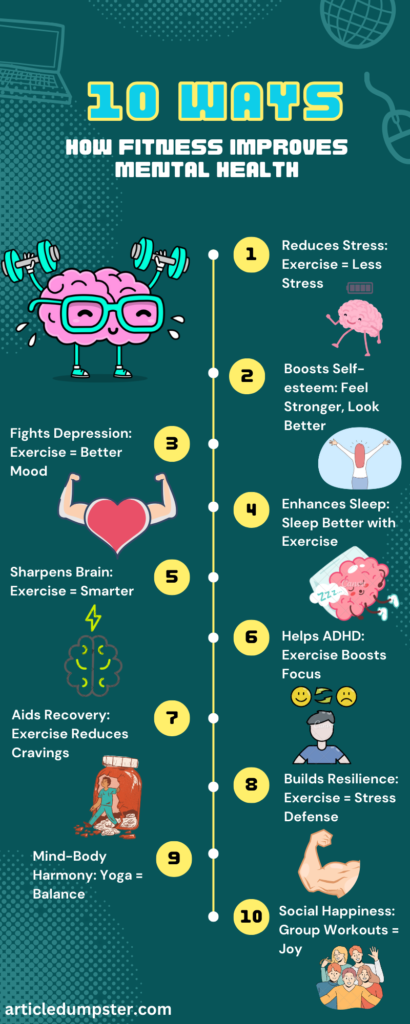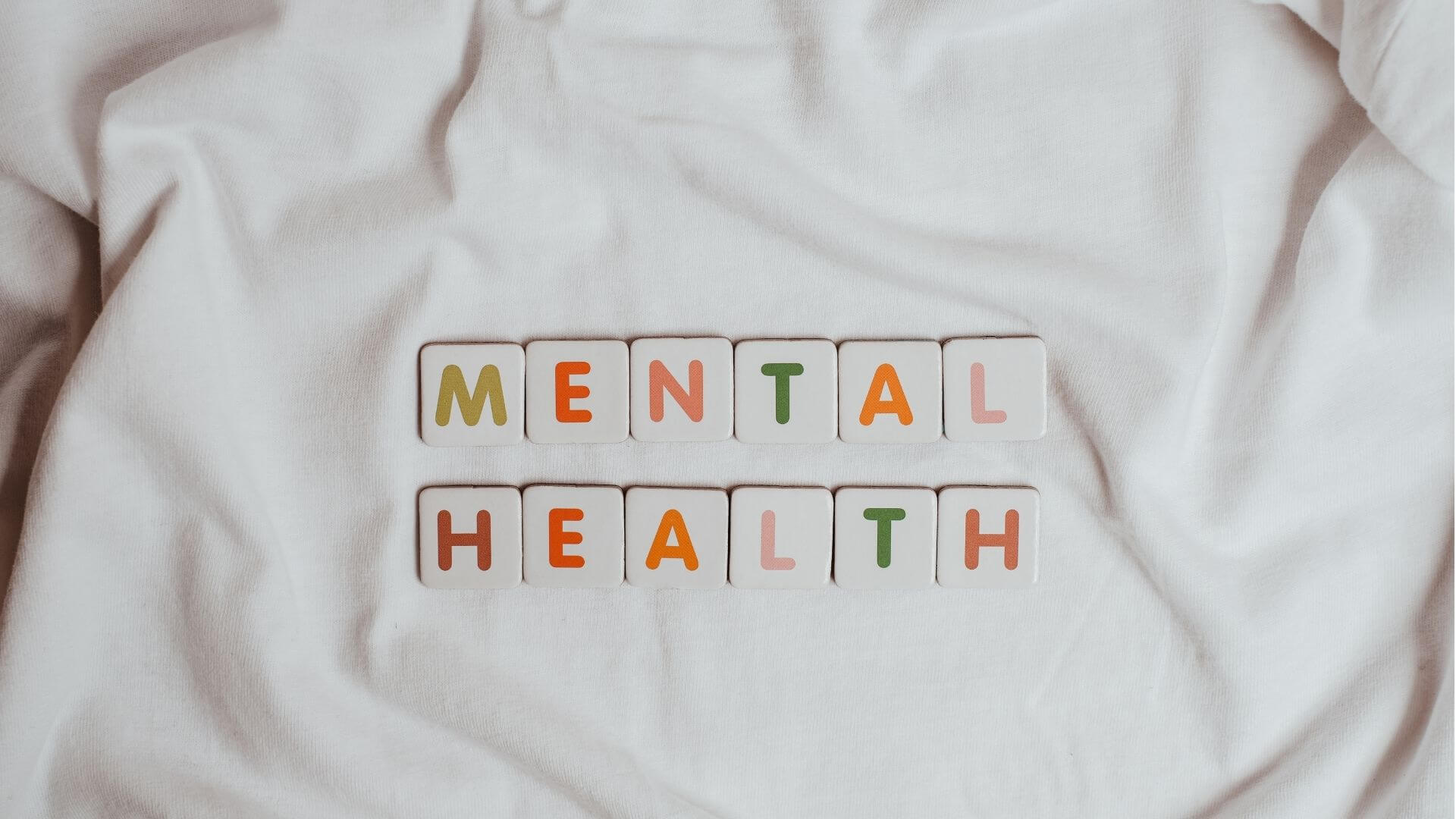Embracing a lifestyle that includes fitness does more than sculpt your physique––it can also do wonders for your mind! Scientific research consistently indicates a strong correlation between physical activity and mental well-being.
Exercising has been proven to alleviate symptoms of depression, anxiety, and stress while also boosting your mood and cognitive abilities. But how exactly does fitness translate to mental health benefits? Glad you asked! We’re diving into the top 10 ways fitness positively impacts mental health, all backed by science.
This isn’t just a feel-good mantra; it’s a fact! So, lace up those sneakers, and let’s explore how a little sweat can go a long way toward a happier, healthier mind.
Here’s How Fitness Improves Mental Health – 10 Scientifically Proven Ways
1. Reduces Stress
We all know that stress can be a real beast! But did you know that exercise can be your knight in shining armor? When you exercise, your body pumps out endorphins, your brain’s feel-good neurotransmitters. These little guys are often called “nature’s antidepressant,” and for good reason. They help reduce feelings of stress and anxiety, leaving you feeling more relaxed and happier. Think of it as a natural happy pill but without the side effects!
2. Improves Self-esteem
Ever heard the saying, “Look good, feel good?” Well, it turns out there’s some truth to it! Regular physical activity can give your self-esteem a real boost. How? Well, when you exercise, you tend to feel stronger and more confident about your body. Plus, smashing through a tough workout can make you feel like you can conquer anything that comes your way. And who doesn’t want that?
3. Fights Depression & Reduces anxiety
Now, this is where things get interesting. Regular exercise can also reduce anxiety feelings and symptoms of post-traumatic stress disorder (PTSD). But wait, there’s more! The endorphins and serotonin (another feel-good neurotransmitter) released during exercise can improve your mood and alleviate symptoms of depression. Even research shows that exercise can be effective in reducing depression symptoms. Talk about a win-win!

4. Improves Sleep
Are you tossing and turning at night, struggling to get some quality shut-eye? Lace-up those sneakers and get moving! Physical activity has increased the time spent in deep sleep, the most restorative sleep phase. Not only that, but it also helps relax the mind, making falling asleep easier and improving overall sleep quality. There’s no need for counting sheep when you’ve got exercise on your side!
5. Boosts Cognitive Function
Last but certainly not least, exercise can give your brain a big boost. Whether you’re trying to improve your attention, memory, thinking abilities, or even your creativity, a little bit of physical activity can help a lot. Exercise stimulates neurogenesis, the process of generating new nerve cells or neurons. This leads to better overall cognitive function, which is just another way of saying “brain performance.” So, the next time you’re feeling a bit foggy up top, why not try going for a jog or hitting the gym? Your mind will thank you for it!
6. Helps in ADHD Management
Fitness is a powerful ally when it comes to managing Attention Deficit Hyperactivity Disorder (ADHD). Regular exercises, whether it’s brisk walking or doing high-intensity workouts, can spike the brain’s dopamine, norepinephrine, and serotonin levels. These key neurotransmitters play a pivotal role in regulating attention and focus. As per a study published in 2020, physical activity significantly improved cognitive function in individuals with ADHD with just a single session. So, if you’re juggling ADHD symptoms, lacing up those sneakers might be a good place to start!
7. Aids Addiction Recovery
Exercise can be a significant contributor to the road to recovery from addiction. It provides a healthy and constructive outlet for redirecting energy away from addictive substances or behaviors. A study found that exercise could help decrease cravings and reduce the use of illicit substances. So, whether it’s hitting the pavement for a run or dancing to your favorite tunes, getting active can create positive ripples in your addiction recovery journey.
8. Enhances Emotional Resilience
Regular exercise isn’t just about flexing muscles; it’s also about fortifying emotional resilience. It’s the ability to bounce back from stressful or adverse situations, and it turns out that breaking a sweat can help build it. Consistent physical activities like cardio workouts or resistance training can help manage stress levels and enhance mood, thus bolstering emotional resilience. A study from the American Psychological Association noted that regular exercise could act as a buffer against stress-related disorders.
9. Fosters Mind-Body Connection
Have you ever heard of the phrase, ‘healthy mind in a healthy body’? It rings true, especially when you engage in physical activities like yoga and pilates. These low-impact exercises are known to strengthen the connection between mind and body, increasing feelings of harmony and self-awareness. A study published in the National Library of Medicine found that yoga practitioners reported better mental health and satisfaction with life.
10. Creates Positive Social Interactions
Fitness isn’t always a solitary journey. Group exercises like Zumba classes, running clubs, or even a simple walk in the park with friends provide an opportunity for positive social interactions. These social exchanges not only enhance mood but also promote better mental health. A study found that participants who exercised in groups reported improved mental health and were happier than those who exercised alone. So, the next time you’re gearing up for a workout, consider inviting a friend or joining a group class!
Remember, fitness is not a one-size-fits-all solution. It’s all about finding the right balance and activities you enjoy and can stick with. As always, before starting any new fitness routine, it’s best to consult with a healthcare professional. Here’s to a healthier mind and a fitter body!
How to Make an Exercise Plan & Take That First Step?
- Set Clear Goals: Determine what you want to achieve with your exercise plan, whether it’s weight loss, muscle gain, improved cardiovascular health, or stress reduction. Having clear goals will motivate you.
- Start Slow: If you’re new to exercise or returning after a break, start with light or moderate-intensity activities. Overexerting yourself at the beginning can lead to burnout or injury.
- Consult a Professional: Consider consulting with a trainer or doctor before starting an exercise plan, especially if you have underlying health conditions.
- Choose Activities You Enjoy: Find exercises you genuinely like. This makes it more likely that you’ll stick to your plan.
- Set a Route: Put aside specific times for your workouts. Consistency is key. Whether it’s mornings, evenings, or lunch breaks, having a routine helps.
- Vary Your Workouts: Include cardiovascular, strength training, and flexibility exercises. This keeps things interesting and engages different muscle groups.
- Progressive Overload: Increase your workout intensity and duration as slowly your fitness level improves.
- Track Your Progress: Keep a workout journal to monitor your accomplishments. This can be motivating and help you see how far you’ve come.
- Listen to Your Body: Pay attention to how your body responds to exercise. If you’re feeling pain, rest or modify your routine accordingly.
- Plan for Rest Days: Rest and recovery are crucial for avoiding burnout and allowing your body to repair and grow stronger.
- Nutrition Matters: A balanced diet complements your exercise plan. Ensure you’re eating well to support your fitness goals.
- Stay Hydrated: Drink enough water before, during, and after your workouts to stay hydrated.
- Invest in Proper Gear: Wear comfortable and appropriate workout attire and invest in good-quality shoes if necessary.
Sample Exercise Plan Table:
Here’s a basic table to help you plan your exercise routine. Customize it to fit your goals and schedule.
| Day | Activity | Duration | Intensity | Notes |
| Monday | Running | 30 mins | Moderate | Park or treadmill |
| Tuesday | Strength Training | 45 mins | Moderate | Full-body workout |
| Wednesday | Yoga | 60 mins | Low | Focus on flexibility and relaxation |
| Thursday | Swimming | 45 mins | Moderate | At the local pool |
| Friday | Cardio (e.g., cycling) | 30 mins | Moderate | On a stationary bike |
| Saturday | Rest or Light Activity | – | – | Gentle walking or stretching |
| Sunday | Hiking | 2 hours | Moderate | Nature trail or nearby hiking spot |




